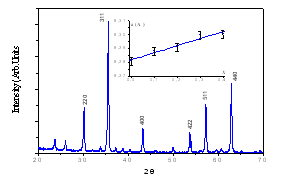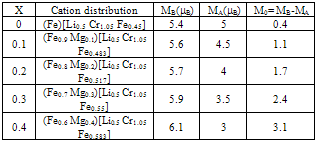-
Paper Information
- Next Paper
- Previous Paper
- Paper Submission
-
Journal Information
- About This Journal
- Editorial Board
- Current Issue
- Archive
- Author Guidelines
- Contact Us
International Journal of Materials and Chemistry
p-ISSN: 2166-5346 e-ISSN: 2166-5354
2012; 2(2): 72-74
doi: 10.5923/j.ijmc.20120202.05
Magnetic Properties of Magnesium Doped Li-Cr Ferrites
A. M. Rais1, A. Addou2, M. Ameri1
1Département de physique, Faculté des Sciences, Université Djilali Liabes , Sidi Bel Abbes, Algeria
2Laboratoire STEVA, Département de chimie, Université de Mostaganem, Mostaganem, Algeria
Correspondence to: A. M. Rais, Département de physique, Faculté des Sciences, Université Djilali Liabes , Sidi Bel Abbes, Algeria.
| Email: |  |
Copyright © 2012 Scientific & Academic Publishing. All Rights Reserved.
Mixed ferrites Cr1.05 Li0.5 Mg x Fe1.45-(2/3)x O4 (0 ≤ x ≤ 0.4) doped with Magnesium have been studied using x-ray diffraction, Mössbauer spectroscopy and magnetic measurements. X-ray diffraction patterns show that all samples have single phase cubic spinel structure. The temperature-dependent magnetic measurements revealed that magnetic compensation disappears when Fe3+ in A-site is partially replaced by Mg2+. Moreover, below the compensation temperature the observed magnetic moment of these ferrites increases with magnesium content. The magnetization data at all concentrations are discussed in the light of Néel’s molecular field model taking into account the cations distribution obtained using the analysis of Mössbauer spectra.
Keywords: Magnetic Compensation, Crystal Structure, X-ray Diffraction, Mössbauer Spectroscopy, Cations Distribution
1. Introduction
- Li0.5Fe2.5O4 has been the subject to extensive technical and fundamental studies both in its pure form as well as its substituted form [1-3]. Various researchers have reported the effect of additions of divalent, trivalent and tetravalent ions in lithium ferrites and the different parameters have been measured depending on the desired application [4–6]. The reason behind these studies has been that the crystal structure and presence solely of Fe3+ ions in the host material has allowed detailed modelling of the exchange interactions giving rise to its ferrimagnetic order and secondly that subsequent substitution either with magnetic or with nonmagnetic cations has allowed studies of a variety of different magnetic states arising from the perturbed magnetic exchange interactions between ions.The chromium-doped lithium ferrites Li0.5Fe2.5-xCrxO4 are among the few systems exhibiting the effect of magnetic compensation and Gorter et al [7, 8] were the first to observe this phenomenon in Cr1.25Li0.5Fe1.25O4. These are ferrimagnetic materials in which the various temperature-dependent magnetizations of the spin-up and spin-down sublattices cross over at temperatures below the Curie temperature, resulting in a change of sign of the net spontaneous magnetization at that temperature. In a previous paper [9], we agreed with Kuznetsov et al [10] that Li0.5 Fe2.5-xCrxO4 ferrites have a completely inverted spinel structure for concentrations up to x = 1.25.In this work, we report the effect of Mg2+ substitution for Fe3+ on the magnetic compensation of Li-Cr ferrite. Moreover, using a Mossbauer study of this system, we propose a cations distribution and investigate its relationship with the magnetic compensation effect.
2. Experimental
- Five samples of the ferrite system Cr1.05 Li0.5 Mg x Fe1.45-(2/3)x O4 (0 ≤ x ≤ 0.4) were prepared by the conventional double-sintering ceramic technique.The X-ray data were collected using a Philips PW1820 vertical goniometer with monochromator attached to a CuKα PW1700 generator operating at a voltage of 40 kV.The magnetization measurements were performed using a vibrating sample magnetometer (VSM) of 10-5 emu sensitivity in the magnetic field range of 0 kOe to 13.5 kOe and in the temperature range of 77 K to 600 K.
3. Results and Discussion
- X-ray diffraction analysis showed the formation of single phase cubic spinel structure for all five samples. A representative diffraction of Cr1.05Li0.5Fe1.45O4 is shown in Fig.1. The major peaks are indexed while the minor peaks indicate the presence of superlattice structures which suggest an ordered arrangement of Li2+ and Fe3+ cations on the octahedral sublattice.The lattice parameter (a) was obtained by extrapolation to θ = 900 for different indexed planes against the Nelson-Riley function. The lattice parameter value of Cr1.05Li0.5Fe1.45O4 agrees well with the literature taking into account our preparation technique. As can be seen in the inset of Fig.1, within error bars the lattice parameter increases slowly with magnesium content.
 | Figure 1. X-ray representative spectrum of Cr1.05Li0.5Fe1.45O4. The inset shows the lattice parameter a (Angstroms) versus magnesium content |
 | Figure 2. Mössbauer spectra of Cr1.05 Li0.5 Mg x Fe1.45-(2/3)x O4 at 77K |
|
4. Conclusions
- We may conclude from the study of the effect of Mg2+ on the magnetic compensation of Chromium-Lithium ferrites that:1. The magnetic compensation in Cr1.05Li0.5Fe1.45O4 disappears when Fe3+ in A-site is partially replaced by Mg2+.2. Below the compensation temperature, the observed magnetic moment of these ferrites increases with magnesium content.3. The magnetic moments calculated using a cations distribution consistent with the Mössbauer study of these ferrites show an increasing trend with magnesium content. This trend agrees with the magnetic measurements.
 | Figure 3. Saturation magnetizations versus temperature of Cr1.05 Li0.5 Mg x Fe1.45-(2/3)x O4. The inset shows the Curie and compensation temperatures versus magnesium content |
References
| [1] | Krishnan R, Physica B 1977, 86-88, 1457. |
| [2] | Dormann J.L, Rev. Phys. Appl. 1980, 15, 1113. |
| [3] | Gill N.K and Puri R.K, Spectrochimica Acta 1985, A 41, 1005. |
| [4] | Deepika K, Sumitra P. and Baijal J S, J. Mater. Sci. 1990, 25, 5142. |
| [5] | Song J. M and Koh J. G., IEEE Trans. Magn. 1996, 32, 411. |
| [6] | Mazen S. A, Metawe F. and Mansour S. F., J. Phys. D:Appl. Phys. 2003, 30 1799. |
| [7] | Gorter E.W and Schulkes J.A, Phys.Rev. 1953, 89, 487. |
| [8] | Gorter E.W. Philips Res.Rep. 1954, 9, 295. |
| [9] | Rais A.M., Gismelseed A.M., and Al-Omari I.A., Phys. Stat. Sol. (b) 2005, 242, 2945 –2955. |
| [10] | Kuznetsov M, Pankhurst Q.A and Parkin I.P, J.Phys.D: Appl.Phys.2002, 31, 2886. |
| [11] | Fatseas G.A, Dorman J.L and Blanchard H, J.Phys. 1976, 12, 787. |
| [12] | Chen Y.L, Xu B.B and Chen J.G, Hyp.Int.1976, 70, 1029. |
| [13] | Kuznetsov M, Pankhurst Q.A and Parkin I.P, J.Phys.D: Appl.Phys. 2002, 31, 2886. |
| [14] | Neel L, Ann.Phys. 1948 3, 137. |
| [15] | Belov K.P, Phys.Usp. 1996, 39, 62 |
 Abstract
Abstract Reference
Reference Full-Text PDF
Full-Text PDF Full-Text HTML
Full-Text HTML
